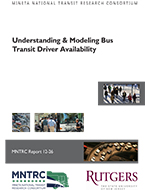Abstract:
Bus transit agencies are required to hire extraboard (i.e. back-up) operators to account for unexpected absences. Incorrect sizing of extra driver workforce is problematic for a number of reasons. Overestimating the appropriate number of extraboard operators has financial implications while underestimating can lead to service disruption. It is therefore important that transit agencies properly manage extraboard operator staffing. A review of relevant literature showed that current models for extraboard management are generally agency-specific and that, in practice, extra driver assignments are usually based on the experience of the decision makers rather than the utilization of a mathematically sound modeling process.
In this study, two mathematical programming models with probabilistic constraints were developed to determine daily optimal extraboard size for bus transit (driver availability and deployment) while incorporating reliability and risk measures in the decision making process. Two distinct solution approaches were proposed. The first approach used pLEP’s as the solution methodology and the second approach used second order stochastic dominance constraints. The models were tested using long-term data obtained from three Tri-County Metropolitan Transportation District of Oregon (TriMet) garage. The individual performance of both models under different cost assumptions was evaluated and then the actual historical assignments were compared with the optimal solutions obtained from these models. The results revealed possible improvements of extra driver size for one of the three garages studied. These models can be easily used in a computerized environment to assist agencies in efficient decision-making, which is also illustrated using a simulation procedure developed for comparison with observed driver assignment data.
Authors:
KAAN OZBAY, PH.D.
Kaan M.A. Ozbay is a professor at the Department of Civil and Urban Engineering at Polytechnic Institute of New York University and Center for Urban Science and Progress (CUSP). Dr. Ozbay’s research interest in transportation covers advanced technology and sensor applications, incident and emergency management, development of real-time control techniques for traffic, traffic safety, application of artificial intelligence and operations research techniques in network optimization, development of simulation models for transit and automated highway systems, and transportation economics. He is co-editor of numerous books, including, most recently, Dynamic Traffic Control & Guidance published by Springer Verlag’s “Complex Social, Economic and Engineered Networks” series in 2013. He has published more than 300 refereed papers in scholarly journals and conference proceedings. Prior coming to NYU, Dr. Ozbay was a tenured full Professor at the Rutgers University Department of Civil and Environmental Engineering. Since 1994, Dr. Ozbay, has been the principal investigator and co-principal investigator of 77 projects funded at a level of more than $11,00,000 by National Science Foundation, NJDOT, NYMTC, NY State DOT, New Jersey Highway Authority, USDOT, FHWA, VDOT, CUNY University Transportation Research Center (UTRC), Department of Homeland Security, and USDOT ITS Research Center of Excellence.
ENDER FARUK MORGUL, M.SC.
Ender F. Morgul works as a graduate research assistant at the Civil and Urban Engineering Department in Polytechnic Institute of New York University. He received his B.S. from Bogazici University and M.Sc. in Civil Engineering from Rutgers University. His research interests include modeling and prediction of driver behavior, transportation economics, urban freight operations, big data and GPS-based transportation data analysis. His 2010 M.Sc. thesis investigated dynamic congestion pricing using large-scale traffic simulations.


